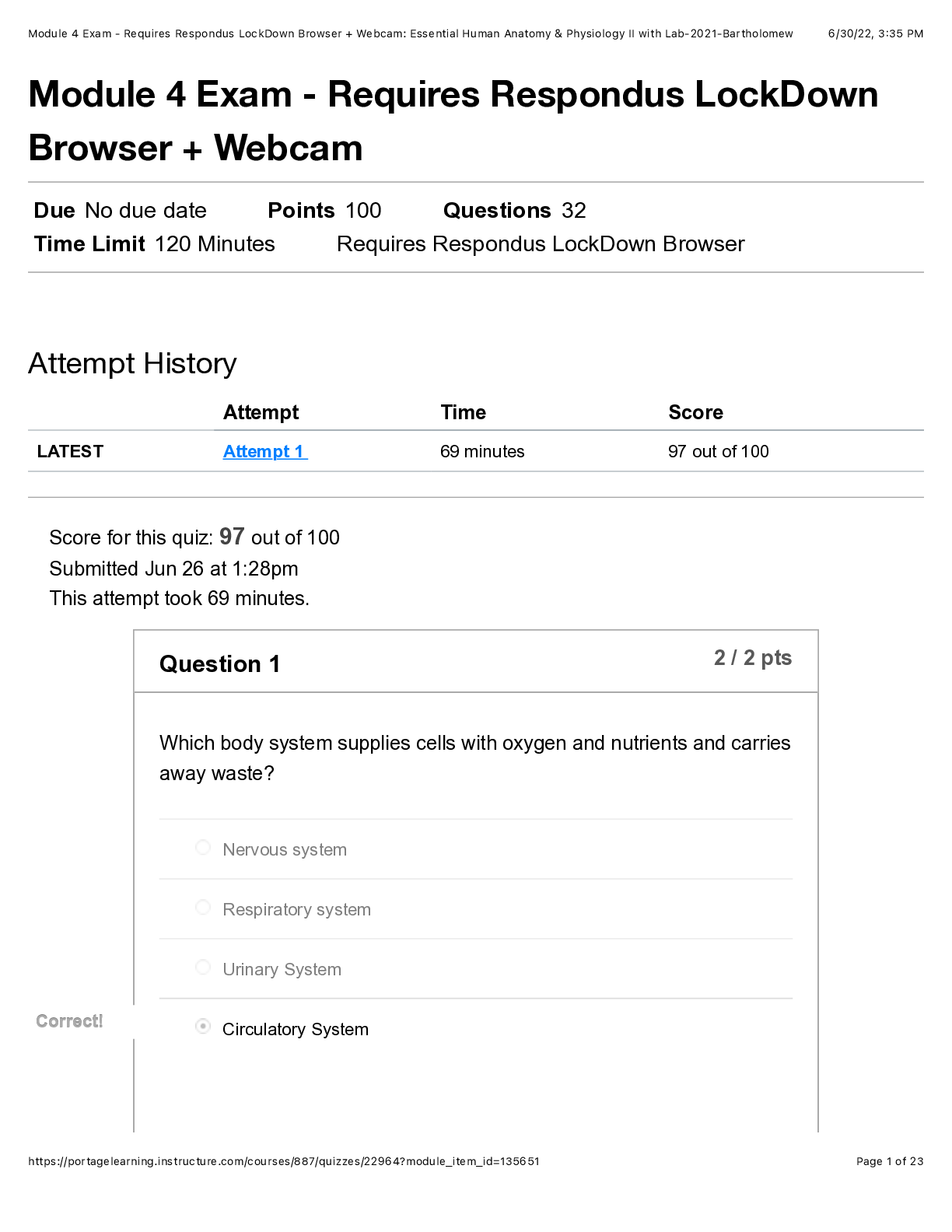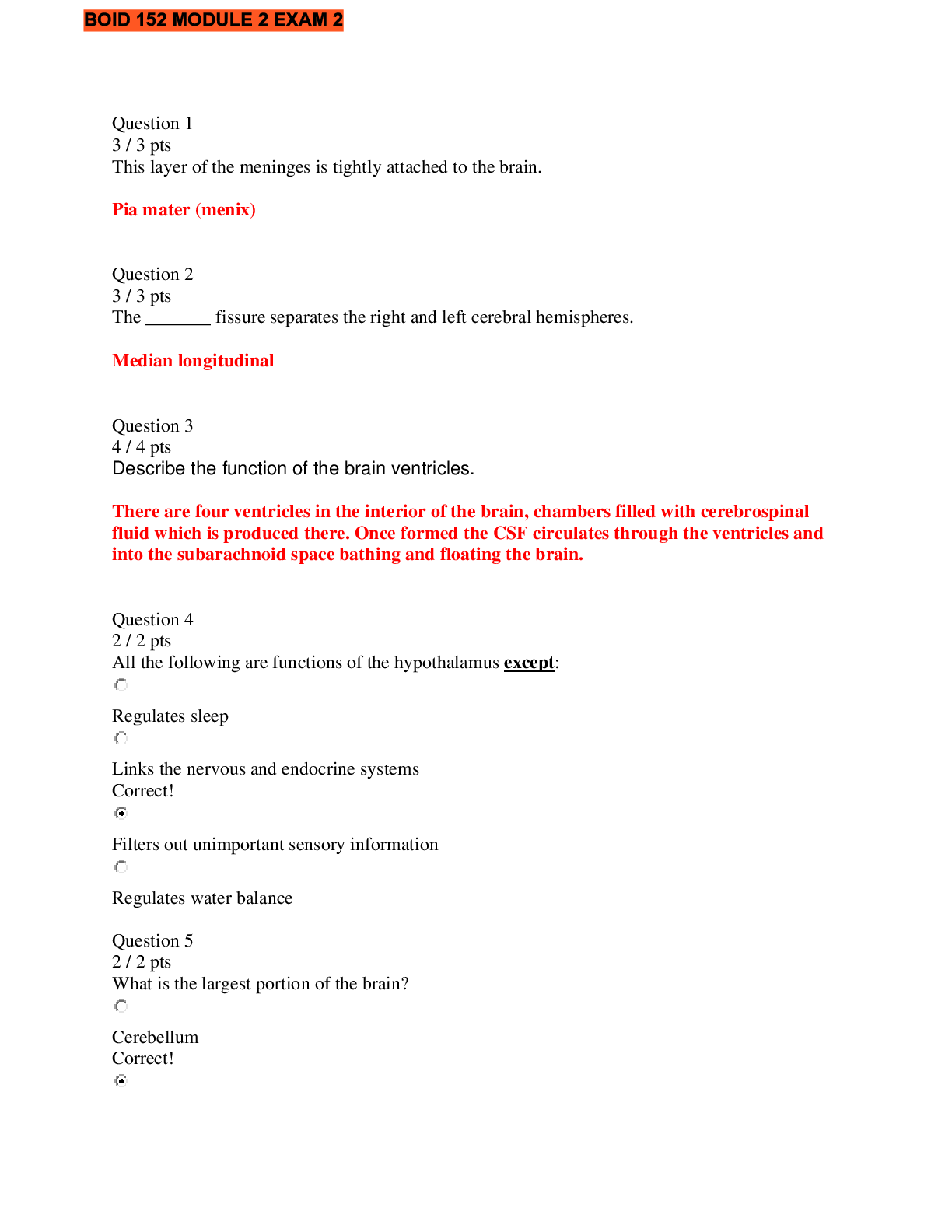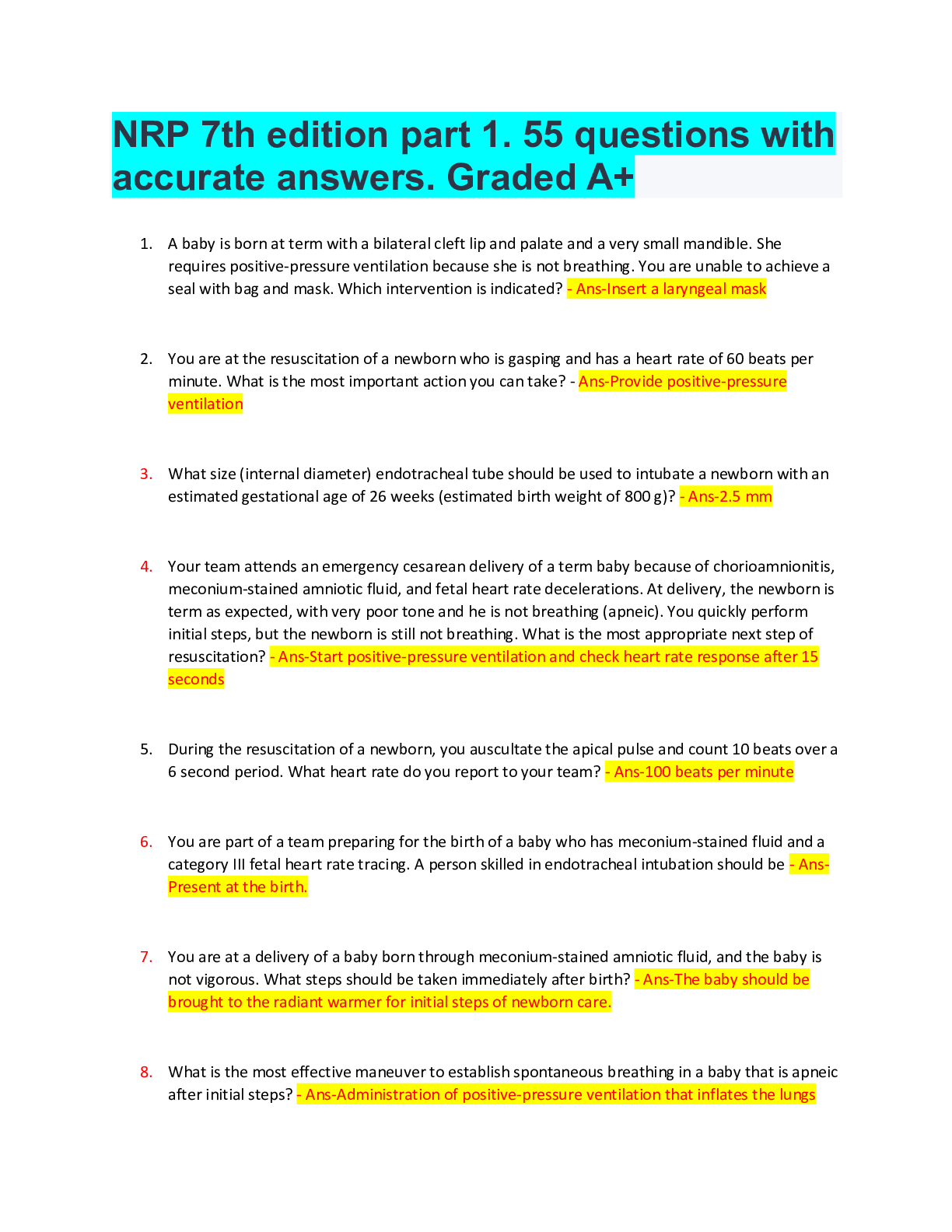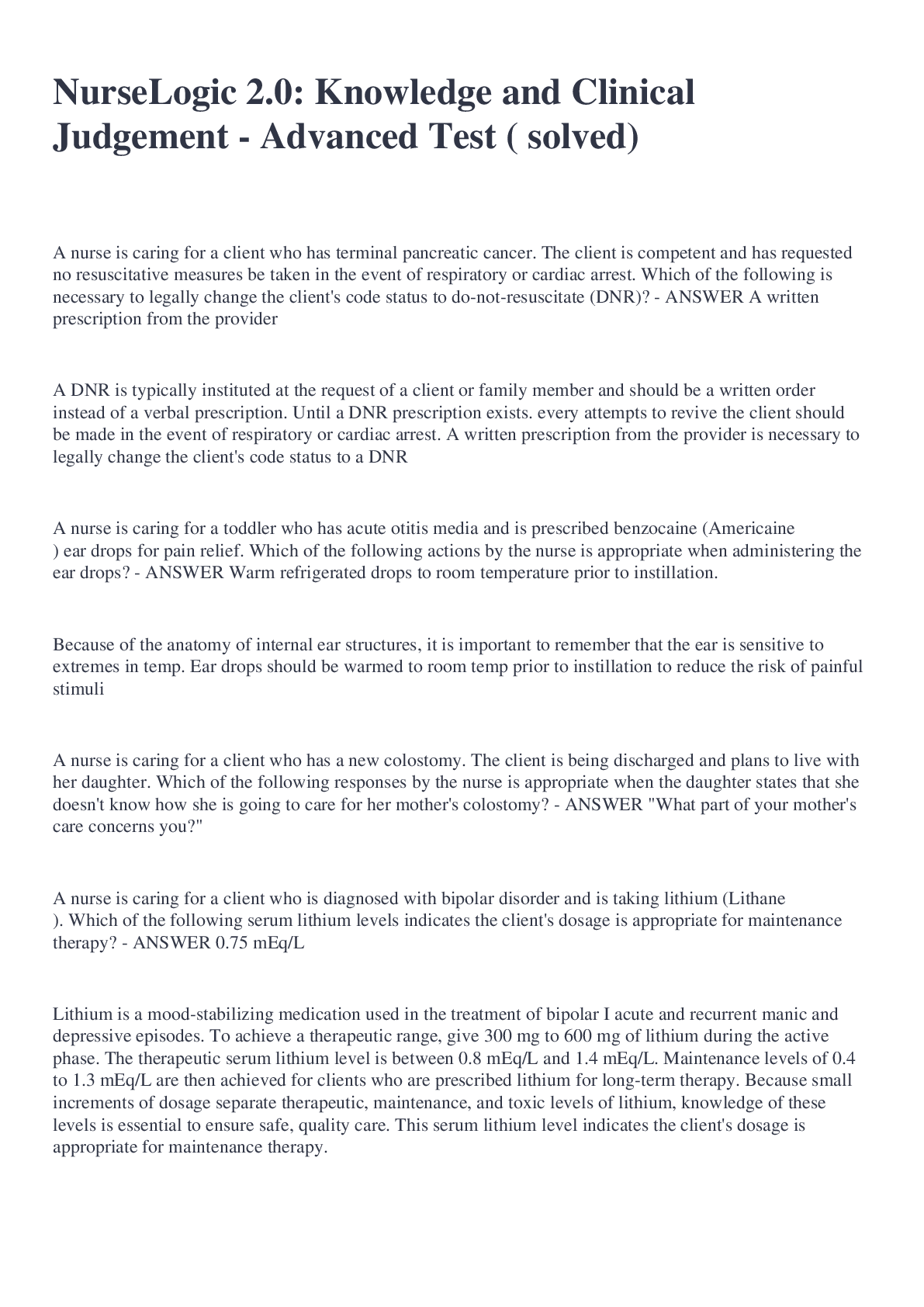*NURSING > QUESTIONS & ANSWERS > Pharmacology-Quiz - 300 Questions.docx,. 100% accurate answers. graded A+ (All)
Pharmacology-Quiz - 300 Questions.docx,. 100% accurate answers. graded A+
Document Content and Description Below
Quiz – 300 questions of Pharmacology - 203 All Answers Question 1 A patient has been selected as a potential recipient of an experimental drug for heart failure. The nurse knows that when inform... ed consent has been obtained, it indicates which of these? Answers: a. The patient has been informed of the possible benefits of the new therapy. b. The patient will be informed of the details of the study as the research continues. c. The patient has had the study’s purpose, procedures, and the risks involved explained to him. d. The patient will receive the actual drug during the experiment. Question 2 During a fishing trip, a patient pierced his finger with a large fishhook. He is now in the emergency department to have it removed. The nurse anticipates that which type of anesthesia will be used for this procedure? Answers: a. No anesthesia b. Topical benzocaine spray on the area c. Topical prilocaine (EMLA) cream around the site d. Infiltration of the puncture wound with lidocaine Question 3 While monitoring a depressed patient who has just started SSRI antidepressant therapy, the nurse will observe for which problem during the early time frame of this therapy? Answers: a. Self-injury or suicidal tendencies b. Loss of appetite c. Extrapyramidal symptoms d. Hypertensive crisis 1 Question 4 The nurse is reviewing the use of central nervous system stimulants. Which of these are indications for this class of drugs? (Select all that apply.) Answers: a. Neonatal apnea b. Attention deficit hyperactivity disorder (ADHD) c. Depression d. Appetite suppression e. Narcolepsy f. Panic attacks Question 5 Which statements are true regarding the elderly and pharmacokinetics? (Select all that apply.) Answers: a. Gastric pH is less acidic. b. Fat content is decreased because of increased lean body mass. c. Fat content is increased because of decreased lean body mass. d. The number of intact nephrons is increased. e. Gastric pH is more acidic. f. The levels of microsomal enzymes are decreased. g. The number of intact nephrons is decreased. Question 6 When giving a buccal medication to a patient, which action by the nurse is appropriate? (Select all that apply.) Answers: a. Placing the medication between the upper or lower molar teeth and the cheek b. Encouraging the patient to swallow, if necessary 2 c. Placing the tablet under the patient’s tongue and allowing it to dissolve completely d. Administering water after the medication has been given Question 7 Which nursing diagnosis is appropriate for the patient who has just received a prescription for a new medication? Answers: a. Deficient knowledge related to newly prescribed drug therapy b. Noncompliance related to new drug therapy c. Impaired memory related to new drug therapy d. Lack of knowledge regarding newly prescribed drug therapy Question 8 During an assessment, the patient tells the nurse that he eats large amounts of garlic for its cardiovascular benefits. Which drug or drug class, if taken, would have a potential interaction with the garlic? Answers: a. Insulin b. Sedatives c. Antilipemic drugs d. Acetaminophen (Tylenol) Question 9 The nurse is reviewing the criteria for over-the-counter drugs. Which criteria for over-the-counter status in the United States are accurate? (Select all that apply.) Answers: a. The drug must be easy to use. b. The consumer must be able to monitor the drug’s effectiveness. c. The drug must have a low potential for abuse. d. The drug must have a low therapeutic index. 3 e. The drug must not have any interactions with other drugs. Question 10 The nurse is monitoring a patient who is in the 26th week of pregnancy and has developed gestational diabetes and pneumonia. She is given medications that pose a possible fetal risk, but the potential benefits may warrant the use of the medications in her situation. The nurse recognizes that these medications are in which U.S. Food and Drug Administration pregnancy safety category? Answers: a. Category C b. Category X c. Category B d. Category D Question 11 A patient has been taking phenobarbital for 2 weeks as part of his therapy for epilepsy. He tells the nurse that he feels tense and that “the least little thing” bothers him now. Which is the correct explanation for this problem? Answers: a. These are adverse effects that usually subside after a few weeks. b. The drug must be stopped immediately because of possible adverse effects. c. This drug causes the rapid eye movement (REM) sleep period to increase, resulting in nightmares and restlessness. d. This drug causes deprivation of REM sleep and may cause the inability to deal with normal stress. Question 12 A patient has experienced insomnia for months, and the physician has prescribed a medication to help with this problem. The nurse expects which drug to be used for long-term treatment of insomnia? Answers: a. Secobarbital (Seconal), a barbiturate b. Diazepam (Valium), a benzodiazepine c. Eszopiclone (Lunesta), a nonbenzodiazepine sleep aid 4 d. Midazolam (Versed), a benzodiazepine Question 13 Which statements are true regarding the selective serotonin reuptake inhibitors (SSRIs)? (Select all that apply.) Answers: a. These drugs have anticholinergic effects, including constipation, urinary retention, dry mouth, and blurred vision. b. Avoid foods and beverages that contain tyramine. c. Monitor the patient for extrapyramidal symptoms. d. Cogentin is often also prescribed to reduce the adverse effects that may occur. e. If the patient has been on an MAOI, a 2- to 5-week or longer time span is required before beginning an SSRI medication. f. Therapeutic effects may not be seen for about 4 to 6 weeks after the medication is started. Question 14 The nurse is reviewing the applications of gene therapy. Which drug is manufactured as a result of indirect gene therapy? Answers: a. Human insulin b. Warfarin c. Vitamin K d. Heparin Question 15 Vicodin (acetaminophen/hydrocodone) is prescribed for a patient who has had surgery. The nurse informs the patient that which common adverse effects can occur with this medication? (Select all that apply.) Answers: a. Diarrhea b. Constipation 5 c. Urinary retention d. Itching e. Nervousness f. Lightheadedness Question 16 The nurse has been monitoring the patient’s progress on a new drug regimen since the first dose and documenting the patient’s therapeutic response to the medication. Which phase of the nursing process do these actions illustrate? Answers: a. Nursing diagnosis b. Planning c. Implementation d. Evaluation Question 17 The nurse is measuring 4 mL of a liquid cough elixir for a child. Which method is most appropriate? Answers: a. Withdrawing the elixir from the container using a calibrated oral syringe b. Withdrawing the elixir from the container using a syringe without a needle attached c. Using a teaspoon to measure and administer d. Holding the medication cup at eye level and filling it to the desired level Question 18 A 25-year-old woman is visiting the prenatal clinic and shares with the nurse her desire to go “natural” with her pregnancy. She shows the nurse a list of herbal remedies that she wants to buy so that she can “avoid taking any drugs.” Which statement by the nurse is correct? Answers: a. “Most herbal remedies are not harmful and are safe for use during pregnancy.” 6 b. “Keep in mind that products from different manufacturers are required to contain consistent amounts of the herbal products.” c. “It’s important to remember that herbal remedies do not have proven safety ratings for pregnant women.” d. “Please read each label carefully before use to check for cautionary warnings.” Question 19 A patient has been given a prescription for levodopa-carbidopa (Sinemet) for her newly diagnosed Parkinson’s disease. She asks the nurse, “Why are there two drugs in this pill?” The nurse’s best response reflects which fact? Answers: a. Carbidopa is the biologic precursor of dopamine and can penetrate into the central nervous system. b. Carbidopa prevents the breakdown of levodopa in the periphery. c. Carbidopa allows for larger doses of levodopa to be given. d. There are concerns about drug-food interactions with levodopa therapy that do not exist with the combination therapy. Question 20 A patient wants to take the herb gingko to help his memory. The nurse reviews his current medication list and would be concerned about potential interactions if he is taking a medication from which class of drugs? Answers: a. Sedatives b. Anticoagulants c. Immunosuppressants d. Digitalis Question 21 When assessing patients in the preoperative area, the nurse knows that which patient is at a higher risk for an altered response to anesthesia? Answers: a. The 40-year-old patient who is to have a kidney stone removed 7 b. The 21-year-old patient who has never had surgery before c. The 35-year-old patient who stopped smoking 8 years ago d. The 82-year-old patient who is to have gallbladder removal Question 22 A patient with a new prescription for a diuretic has just reviewed with the nurse how to include more potassium in her diet. This reflects learning in which domain? Answers: a. Affective b. Psychomotor c. Cognitive d. Physical Question 23 When teaching a patient about taking a newly prescribed antiepileptic drug (AED) at home, the nurse will include which instruction? Answers: a. “Antacids can be taken with the AED to reduce gastrointestinal adverse effects.” b. “If seizures recur, take a double dose of the medication.” c. “Regular, consistent dosing is important for successful treatment.” d. “Driving is allowed after 2 weeks of therapy.” Question 24 The nurse is about to give a rectal suppository to a patient. Which technique would facilitate the administration and absorption of the rectal suppository? Answers: a. Encouraging the patient to lie on his or her left side for 15 to 20 minutes after insertion b. Having the patient hold his or her breath during insertion of the medication c. Having the patient lie on his or her right side, unless contraindicated d. Lubricating the suppository with a small amount of petroleum-based lubricant before insertion 8 Question 25 A patient is to receive acetylcysteine (Mucomyst) as part of the treatment for an acetaminophen (Tylenol) overdose. Which action by the nurse is appropriate when giving this medication? Answers: a. Giving the medication undiluted for full effect b. Preparing to give this medication via a nebulizer c. Disguising the flavor with soda or flavored water d. Avoiding the use of a straw when giving this medication Question 26 A 38-year-old male patient stopped smoking 6 months ago. He tells the nurse that he still feels strong cigarette cravings and wonders if he is ever going to feel “normal” again. Which statement by the nurse is correct? Answers: a. “These cravings may persist for several months.” b. “It’s possible that these cravings will never stop.” c. “The cravings show that you are about to experience nicotine withdrawal.” d. “The cravings tell us that you are still using nicotine.” Question 27 During discharge patient teaching, the nurse reviews prescriptions with a patient. Which statement is correct about refills for an analgesic that is classified as Schedule C-III? Answers: a. Refills are allowed only by written prescription. b. Written prescriptions expire in 12 months. c. No prescription refills are permitted. d. The patient may have no more than five refills in a 6-month period. 9 Question 28 A patient has been taking the monoamine oxidase inhibitor (MAOI) phenelzine (Nardil) for 6 months. The patient wants to go to a party and asks the nurse, “Will just one beer be a problem?” Which advice from the nurse is correct? Answers: a. “You can drink beer as long as you have a designated driver.” b. “If you begin to experience a throbbing headache, rapid pulse, or nausea, you’ll need to stop drinking.” c. “Now that you’ve had the last dose of that medication, there will be no further dietary restrictions.” d. “You need to avoid all foods that contain tyramine, including beer, while taking this medication.” Question 29 Drug transfer to the fetus is more likely during the last trimester of pregnancy for which reason? Answers: a. Increased placental surface area b. Enhanced blood flow to the fetus c. Increased amount of protein-bound drug in maternal circulation d. Decreased fetal surface area Question 30 A patient has been taking temazepam (Restoril) for intermittent insomnia. She calls the nurse to say that when she takes it, she sleeps well, but the next day she feels “so tired.” Which explanation by the nurse is correct? Answers: a. “These drugs affect the sleep cycle, resulting in daytime sleepiness.” b. “These drugs increase the activity of the central nervous system, making you tired the next day.” c. “Long-term use of this drug results in a sedative effect.” d. “If you take the drug every night, this hangover effect will be reduced.” 10 Question 31 The nurse can prevent medication errors by following which principles? (Select all that apply.) Answers: a. Use two patient identifiers before giving medications. b. Assess for allergies after giving medications. c. Use trade names instead of generic names to avoid confusion. d. Minimize the use of verbal and telephone orders. e. Do not give a medication that another nurse has drawn u [Show More]
Last updated: 2 years ago
Preview 1 out of 34 pages

Buy this document to get the full access instantly
Instant Download Access after purchase
Buy NowInstant download
We Accept:

Reviews( 0 )
$12.00
Can't find what you want? Try our AI powered Search
Document information
Connected school, study & course
About the document
Uploaded On
Mar 20, 2022
Number of pages
34
Written in
Additional information
This document has been written for:
Uploaded
Mar 20, 2022
Downloads
0
Views
165



 (1).png)
.png)







.png)










